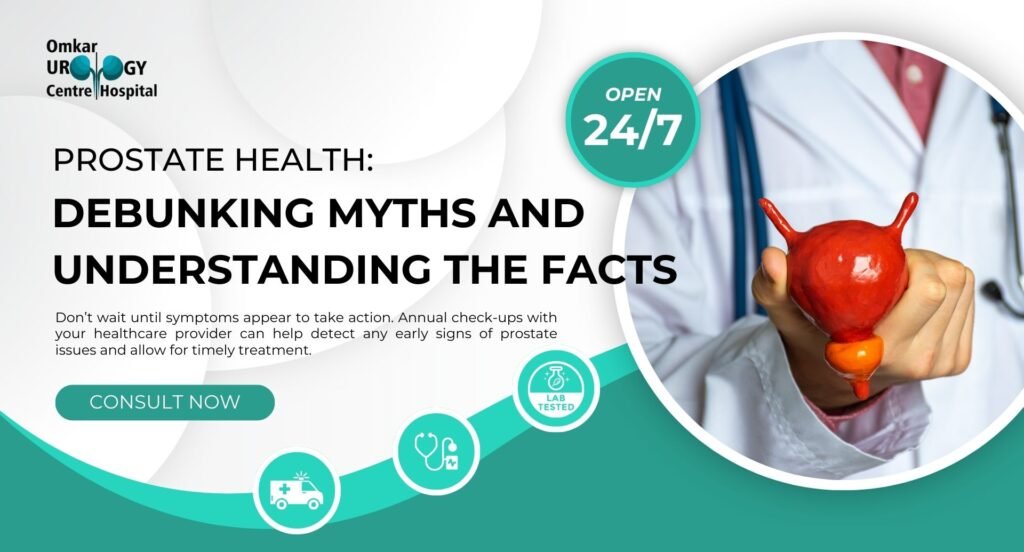
Benign Prostatic Hyperplasia (BPH), also known as an enlarged prostate, is a common condition that affects men as they age. While BPH itself is not cancerous, it can cause a variety of urinary problems that impact a man’s quality of life. In this blog, we will explore the symptoms, causes, and treatment options for BPH, helping you understand this condition better and take the necessary steps for effective management.
Symptoms of Benign Prostatic Hyperplasia (BPH)
The symptoms of BPH are often related to urinary difficulties and can vary in severity. Common signs include:
- Frequent Urination
Men with BPH may feel the need to urinate more often, especially at night (nocturia). This can disrupt sleep and make daily activities inconvenient. - Weak or Interrupted Urine Flow
BPH can cause a weak or interrupted stream of urine, making it difficult to empty the bladder fully. - Difficulty Starting Urination
Men with BPH may experience difficulty initiating urination, as the enlarged prostate can obstruct the flow of urine. - Straining to Urinate
Some men may need to strain or push harder to start or maintain urination, leading to discomfort. - Dribbling After Urination
Dribbling of urine after finishing can be a sign of an enlarged prostate, as the gland may continue to exert pressure on the urethra. - Painful Urination or Blood in Urine
Although less common, some men may experience pain or blood in the urine, which may indicate a more severe case of BPH or an underlying condition.
Causes of Benign Prostatic Hyperplasia (BPH)
The exact cause of BPH remains unknown, but several factors contribute to its development:
- Age
Age is the primary risk factor for BPH. As men age, their prostate glands often enlarge due to hormonal changes, especially the increase in the ratio of estrogen to testosterone. - Hormonal Changes
Changes in hormone levels over time can contribute to prostate growth. The balance between dihydrotestosterone (DHT) and estrogen, both of which influence prostate growth, plays a significant role in BPH development. - Family History
Men with a family history of BPH are at a higher risk of developing the condition. Genetics may influence prostate growth patterns and susceptibility. - Obesity and Lifestyle Factors
Men who are obese or have a sedentary lifestyle may be at higher risk for developing BPH. Diets high in fat and low in fiber have also been linked to prostate enlargement. - Other Health Conditions
Conditions like diabetes, high blood pressure, and heart disease may increase the likelihood of developing BPH, possibly due to the effects these conditions have on hormone levels and prostate health.
Treatment Options for Benign Prostatic Hyperplasia (BPH)
The good news is that BPH can be managed effectively with a range of treatments, from lifestyle changes to medications and surgery. Here are the most common treatment options:
- Medications
- Alpha-Blockers: These medications help relax the muscles in the prostate and bladder neck, making urination easier.
- 5-Alpha-Reductase Inhibitors: These drugs help shrink the prostate by blocking the hormones that cause it to enlarge.
- Combination Therapy: In some cases, a combination of alpha-blockers and 5-alpha-reductase inhibitors is prescribed for better results.
- Lifestyle Changes
- Reducing fluid intake before bed can help minimize nighttime urination.
- Avoiding alcohol and caffeine, which can irritate the bladder.
- Regular exercise and a balanced diet can improve prostate health and reduce BPH symptoms.
- Minimally Invasive Procedures
- Transurethral Microwave Therapy (TUMT): This procedure uses microwave energy to destroy excess prostate tissue, relieving urinary symptoms.
- Transurethral Needle Ablation (TUNA): This technique uses radiofrequency energy to shrink the prostate.
- Laser Therapy: High-energy lasers can be used to remove or shrink excess prostate tissue.
- Surgical Treatments
- Transurethral Resection of the Prostate (TURP): This is the most common surgical treatment, where excess prostate tissue is removed to relieve blockage.
- Prostatectomy: In more severe cases, part of the prostate may be surgically removed.
When to Seek Medical Help
If you are experiencing symptoms of BPH, it is important to consult a healthcare professional for proper evaluation and treatment. Early intervention can prevent symptoms from worsening and improve your quality of life.
Omkar Urology Hospital – The Best Urology Hospital in Varanasi
For comprehensive care and treatment of Benign Prostatic Hyperplasia (BPH) and other urological issues, Omkar Urology Hospital in Varanasi is the best choice. With a team of expert urologists and advanced treatment options, Omkar Urology Hospital is committed to providing the highest quality care for all your urological problems. Whether you’re dealing with BPH, urinary issues, or other urological conditions, Omkar Urology Hospital is dedicated to offering personalized and effective treatment. Contact us today for a consultation and take control of your prostate health.








